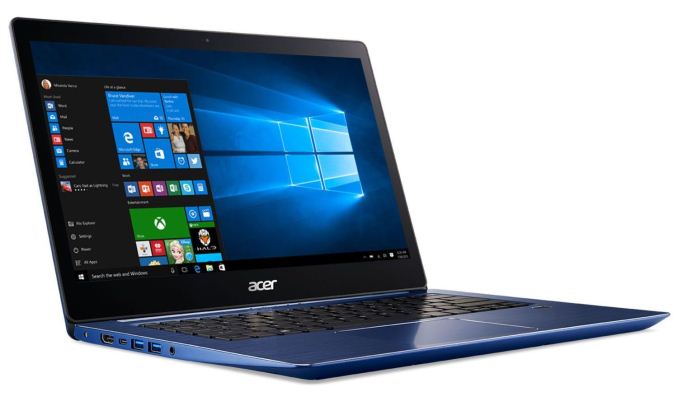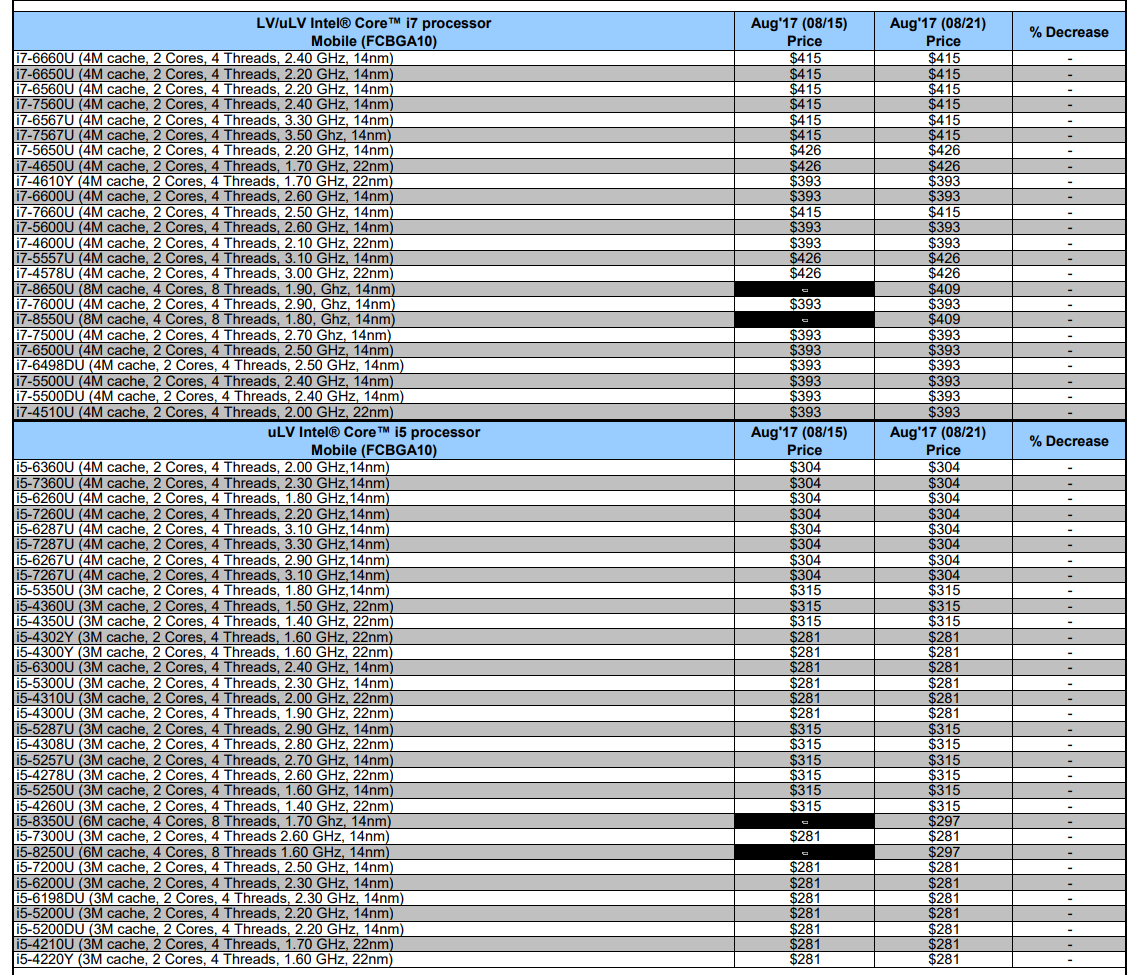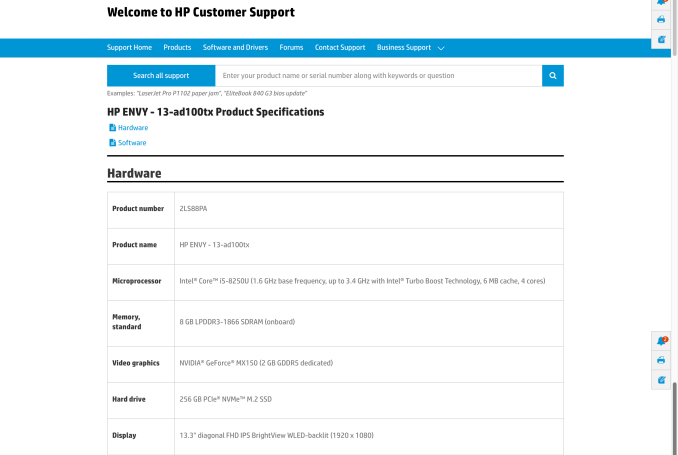Unannounced 8th Generation Core 15W U-Series CPUs Appear on Intel’s Public Price List
by Ian Cutress on August 18, 2017 9:45 AM EST- Posted in
- CPUs
- Intel
- Core 8th Gen
- Price List
- U-Series
- 15W

More news from Intel this morning, this time published directly on their website. With the upcoming announcement of the 8th Generation Core next week to which Intel has already posted teasers to the media, it would seem that someone at Intel decided to add processor details and pricing into Intel’s official Price List today.
New to the document are four CPUs, all in the U-series range, which usually indicates TDPs of 15W for non-Iris products. However, the big jump to note will be in the core counts. U-series processors, including the Core i7 parts, have historically been only dual-core with Hyper-Threading, similar to the Core i5 parts (with the Core i7 being better for voltage/frequency curves and overall performance). The Price List shows that both the new Core i7-8000 and Core i5-8000 parts will move up to four cores, and both will feature Hyper-Threading, giving a total of eight threads.
| Specifications of Intel Core i5/i7 U-series CPUs | |||||||||||
| 7th Generation | 8th Generation | ||||||||||
| Cores | Freq + Turbo |
L3 | Price | Cores | Freq + Turbo |
L3 | Price | ||||
| i7-7660U | 2/4 | 2.5 GHz | 4 MB | $415 | i7-8650U | 4/8 | 1.9/? GHz | 8 MB | $409 | ||
| i7-7560U | 2.4 GHz | $415 | i7-8550U | 1.8/4.0 GHz | $409 | ||||||
| i5-7360U | 2/4 | 2.3 GHz | 3 MB | $304 | i5-8350U | 4/8 | 1.7/? GHz | 6 MB | $297 | ||
| i5-7260U | 2.2 GHz | $304 | i5-8250U | 1.6/3.4 GHz | $297 | ||||||
The Price List also states their L3 cache sizes, which is consistent with previous Core i7/i5 positioning. The base frequencies are to note, which are lower than previous generations. Other information shows the pricing is about the same, and the that these are on 14nm. It doesn’t state which 14nm process these parts are on, but it confirms that 10nm isn’t ready as of today to go into the list. The list also doesn't state the CPUs' turbo frequencies.
One thing that might have users disappointed is that there is no update on any desktop parts in the price list. The list has the new U-series CPUs as having an official price from August 21st, which would also follow some of the laptop designs that have been leaked by retailers featuring these new parts. The image at the top is of the Acer Swift 3 SF314-52G-55XD, which is one of those devices.
Update: 8/18, 2pm ET
HP seems to have published information about its new HP Envy 13 laptop, with additional information on turbo speeds for the i5-8250U and i7-8550U.
Related Reading
Source: Intel Price List












42 Comments
View All Comments
dullard - Friday, August 18, 2017 - link
cmon Bullwinkle, you could at least attempt to hide your bias by also complaining in Anandtech AMD pre-launch drip pipeline posts:http://www.anandtech.com/show/11689/amd-threadripp...
http://www.anandtech.com/show/11678/amd-threadripp...
SaolDan - Friday, August 18, 2017 - link
I5 with 4/8? 4/4 sounds more likely.Rictorhell - Friday, August 18, 2017 - link
These are the parts that go into the type of devices that I am usually more interested in these days but the performance would have to increase significantly for me to really get excited for these parts and the battery life on the devices that use these parts would have to be AT LEAST 6 or 7 hours, minimum.Again, Intel, Lenovo, HP, whoever, some of us measure battery life with our brightness turned all the way up, we need devices that can last for hours without us having to make a ton of compromises in return.
A lot of sites do measure battery life with a certain percentage of brightness or a certain nit, but I think manufacturers need to work on coming up with display technology that is bright AND at least a bit more energy efficient than a lot of current devices that are out there right now.
HStewart - Thursday, August 24, 2017 - link
I think this is why we see so low based Frequencies on these chips - but still have high turbo - I have a Dell XPS 13 2in1 and it will dynamically change frequency based on load - this way during normal operations or idle, it runs at lower frequency and when in demand - runs at higher frequency - so if under higher demand load, it like uses more battery.hasta666 - Friday, August 18, 2017 - link
Everyone can thank AMD and the hype they created with TR. So much hype that I bought one myself, 10 years after my current build (i7 920). I was convinced in a fews. They brought something new at last. Good for customers in the end.Lolimaster - Friday, August 18, 2017 - link
If you encode in x264 10bit or x265 the improve over that i7 920 should be criminal.HStewart - Thursday, August 24, 2017 - link
I would think Intel has had plans for quad core U chips for a long while - maybe for X series chips can thank AMD - but I would think this mobile effort has been in works.One interesting thought - is news of Atom C3xxx series including 16 core server chip at 35 watts - what if they research going mobile with a low power - high core count. No GPU which could explain why they could do it
HStewart - Friday, August 18, 2017 - link
Keep in mind these are U chips - and having quad core on these chips is going to be nice. Hopefully Intel designs in a mode to use only half the core and go at higher speeds - or with Hyperthreading is off.So are these CPU's Coffee Lake U chips and I be curious if they have a Y version.
So it be interesting to see difference between 10nm and 14nm 8 series U chips. Hopefully lower power / batter battery / higher performance / more cores and cache.
bodonnell - Friday, August 18, 2017 - link
From what I understand from previous road maps (and this may have changed) The Y chips version (and some dual core U chips too apparently) will be 10 nm Cannon Lake. Cannon Lake will only be the smaller/low wattage chips while Coffee Lake will be the larger and higher powered chips until everything is on the same process again with Ice Lake. It'll be interesting to see if Intel refers to both Coffee Lake and Cannon Lake at 8th Generation.HStewart - Thursday, August 24, 2017 - link
Likely for Ice Lake, but this announcement of quad core U chips changes things, there is no reason that 10nm Cannon Lake will not be quad core - only thing I can think is that Cannon lake will provide even lower power and same for Y versions.One big difference in Cannon Lake - is that it suppose to have AVX-512 which appears to need additional power to run.